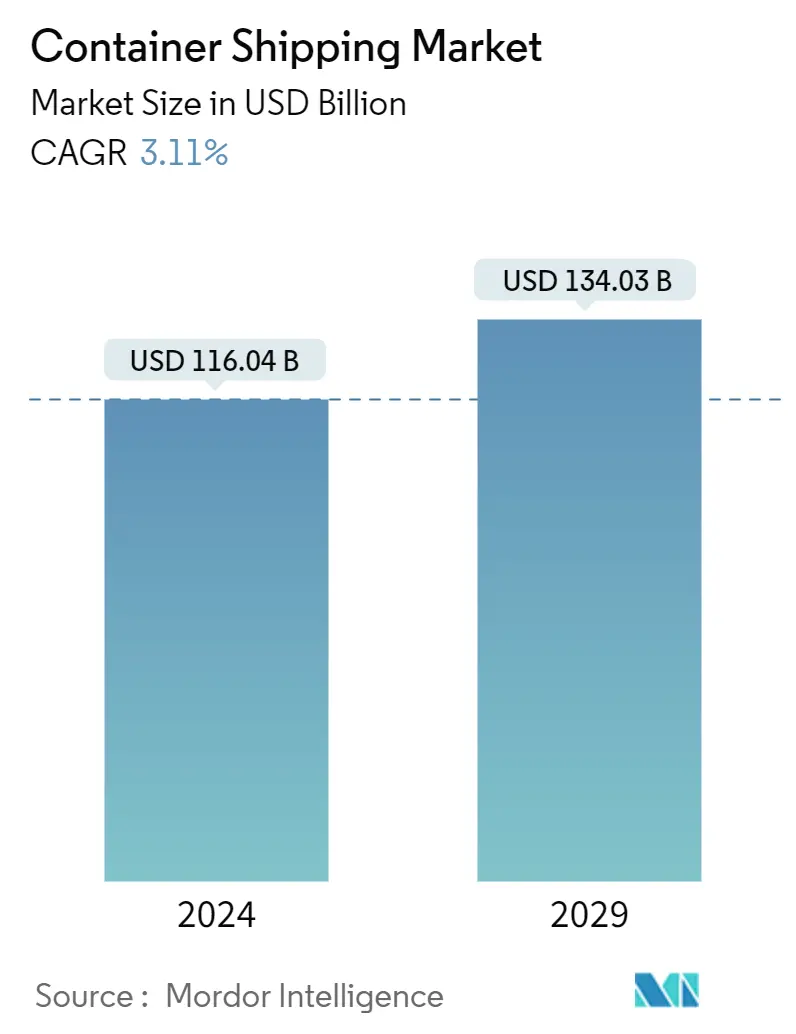Market Size of Container Shipping Industry

| Study Period | 2020- 2029 |
| Market Size (2024) | USD 116.04 Billion |
| Market Size (2029) | USD 134.03 Billion |
| CAGR (2024 - 2029) | 3.11 % |
| Fastest Growing Market | Asia Pacific |
| Largest Market | North America |
Major Players
*Disclaimer: Major Players sorted in no particular order |
Container Shipping Market Analysis
The Container Shipping Market size is estimated at USD 116.04 billion in 2024, and is expected to reach USD 134.03 billion by 2029, growing at a CAGR of 3.11% during the forecast period (2024-2029).
- The global container shipping industry may be dealing with a volatile situation in the Red Sea. Still, this year should provide plenty of moments for most professionals in space. Supply chain professionals are strategically rethinking trade routes and embracing technology to foster resilience and innovation. While shipping companies are optimistic about the industry’s growth, they remain vigilant, recognizing potential disruptions, such as geopolitical tensions.
- Investments in technology and planning are the top investment trend, with 30% of respondents saying that is where they spend money. Real-time visibility and tracking (24%), collaboration and connectivity (27%), and process automation (18%) also appeared on the list.
- The increase in volumes transported was due to the pick-up in global economic activity following the easing of various lockdown measures, the strong momentum in terms of the consumption of goods encouraged in some locations by support packages, strong e-commerce growth with inventory rebuilding, and the usual seasonal variation in business activity.
- A heightened focus on corporate sustainability goals and new regional regulations from the European Union (EU) puts sustainability at the top of mind for many shippers and carriers heading into this year.
- For example, under the EU’s Carbon Border Adjustment Mechanism (CBAM) law, all EU importers need to report carbon emissions related to the production of certain products. Additionally, starting January 1, carriers shipping to, from, or within the European Economic Area (EEA) are subject to the EU’s new Emission Trading System (ETS) regulations, which were expanded to include maritime shipping.
- Many ocean carriers have already made progress toward more sustainable shipping, including using slow steaming to meet emissions standards like the 2023 IMO GHG Strategy and introducing biofuels such as ammonia, methanol, and recycled cooking oil. However, the new requirements from the European Union may lead carriers to adjust schedules, implement surcharges, or make other changes to meet their sustainability goals, which would inevitably impact shippers.
Container Shipping Industry Overview
Container shipping refers to transportation through containers from one place to another. Unlike conventional shipping, container shipping uses containers of various standard sizes to load, transport, and unload goods or objects. As a result, containers can be moved by trains, ships, and trucks.
The report provides a comprehensive background analysis of the container shipping market, covering the current market trends, restraints, technological updates, and detailed information on various segments and the industry's competitive landscape. The impact of COVID-19 has also been incorporated and considered during the study.
The container shipping market is segmented by size (small, large, and high cube containers), type (general container shipping and reefer container shipping), and geography (North America, Europe, Asia-Pacific, Middle East and Africa, and South America). The report offers market size and forecasts value (USD) for all the above segments.
| By Size | |
| Small Containers | |
| Large Containers | |
| High Cube Containers |
| By Type | |
| General Container Shipping | |
| Reefer Container Shipping |
| By Geography | |||||||||||
| |||||||||||
| |||||||||||
| |||||||||||
| |||||||||||
|
Container Shipping Market Size Summary
The container shipping market is poised for steady growth over the forecast period, driven by increased global trade and the rising demand for cargo transport via maritime routes. The industry is characterized by a fragmented landscape with numerous international players, including major companies like Maersk, MSC, CMA CGM, COSCO, and Hapag-Lloyd. The market's expansion is supported by the ongoing industrialization and seaborne trade growth worldwide. However, the sector faces challenges such as geopolitical tensions and fluctuating transportation costs, which necessitate strategic investments in technology and process automation to enhance resilience and efficiency. The focus on sustainability is also becoming increasingly important, with new regulations from the European Union prompting carriers to adopt more eco-friendly practices and technologies.
The market dynamics are further influenced by regional developments and strategic partnerships, as seen in recent agreements and acquisitions aimed at enhancing logistics capabilities and expanding service offerings. For instance, SITC's collaboration with Xiamen Port Holdings Group and Maersk's acquisition of Martin Bencher Group highlight the industry's shift towards digital transformation and comprehensive logistics solutions. Additionally, the use of high-cube containers is gaining traction due to their ability to maximize cargo volume, particularly for light and voluminous goods. As the industry navigates these trends and challenges, the container shipping market is expected to continue its upward trajectory, with a focus on innovation, sustainability, and strategic growth initiatives.
Container Shipping Market Size - Table of Contents
-
1. MARKET DYNAMICS AND INSIGHTS
-
1.1 Current Market Scenario
-
1.2 Market Dynamics
-
1.2.1 Drivers
-
1.2.1.1 Increasing volume of international trade
-
1.2.1.2 The rise of trade agreements between nations
-
-
1.2.2 Restraints
-
1.2.2.1 Surge in fuel costs affecting the market
-
1.2.2.2 Increasing trade tension
-
-
1.2.3 Opportunities
-
1.2.3.1 Technological advancements in the market
-
1.2.3.2 Expanding global trade
-
-
-
1.3 Value Chain/Supply Chain Analysis
-
1.4 Industry Policies and Regulations
-
1.5 Technological Developments in the Logistics Sector
-
1.6 Industry Attractiveness - Porter's Five Forces Analysis
-
1.6.1 Threat of New Entrants
-
1.6.2 Bargaining Power of Buyers/Consumers
-
1.6.3 Bargaining Power of Suppliers
-
1.6.4 Threat of Substitute Products
-
1.6.5 Intensity of Competitive Rivalry
-
-
1.7 Impact of COVID-19 on the Market
-
1.8 Insights into End Users in the Market
-
-
2. MARKET SEGMENTATION
-
2.1 By Size
-
2.1.1 Small Containers
-
2.1.2 Large Containers
-
2.1.3 High Cube Containers
-
-
2.2 By Type
-
2.2.1 General Container Shipping
-
2.2.2 Reefer Container Shipping
-
-
2.3 By Geography
-
2.3.1 North America
-
2.3.1.1 United States
-
2.3.1.2 Canada
-
2.3.1.3 Mexico
-
2.3.1.4 Rest of North America
-
-
2.3.2 Europe
-
2.3.2.1 Germany
-
2.3.2.2 France
-
2.3.2.3 United Kingdom
-
2.3.2.4 Italy
-
2.3.2.5 Rest of Europe
-
-
2.3.3 Asia-Pacific
-
2.3.3.1 China
-
2.3.3.2 Japan
-
2.3.3.3 Australia
-
2.3.3.4 India
-
2.3.3.5 Singapore
-
2.3.3.6 Malaysia
-
2.3.3.7 Indonesia
-
2.3.3.8 Thailand
-
2.3.3.9 Rest of Asia-Pacific
-
-
2.3.4 Middle East and Africa
-
2.3.4.1 Egypt
-
2.3.4.2 Qatar
-
2.3.4.3 Saudi Arabia
-
2.3.4.4 United Arab Emirates
-
2.3.4.5 South Africa
-
2.3.4.6 Rest of Middle East and Africa
-
-
2.3.5 South America
-
2.3.5.1 Brazil
-
2.3.5.2 Colombia
-
2.3.5.3 Rest of South America
-
-
-
Container Shipping Market Size FAQs
How big is the Container Shipping Market?
The Container Shipping Market size is expected to reach USD 116.04 billion in 2024 and grow at a CAGR of 3.11% to reach USD 134.03 billion by 2029.
What is the current Container Shipping Market size?
In 2024, the Container Shipping Market size is expected to reach USD 116.04 billion.

